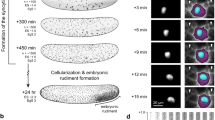Abstract
The formation of a body plan from an initially radially symmetrical egg during animal development is presumed to involve a ‘positional system’1,2 and a subsequent mechanism of local response to position values provided by this system. Early gene products intimately connected with the latter response mechanism have been identified in Drosophila3,5, and because these share conserved sequences with possible counterparts in vertebrates, there is renewed interest in understanding the physiological nature of the positional system itself in a vertebrate embryo. In the frog Xenopus, body position value appears to be specified in outline across much of the egg material by stages comprising a few cells, after only ∼2 h of development6–10. This is already suggestive of a structural or mechanical recording system rather than a diffusion-controlled gradient. I describe here an experiment aimed at perturbing the positional system by causing gravity-driven rearrangements within eggs which conflict with their own, self-organizing rearrangements near the time of first cleavage. The system appears to retain its full regulatory properties during only a brief time interval, so that records of positional profiles disturbed at the close of that interval are permanent, and give rise to systematically abnormal body patterns in otherwise healthy larvae. The results are inconsistent with the notion that Xenopus primary pattern results from a set of determinant ‘plasms’ in the egg, or from a mechanism dominated by long-range diffusion of molecules11,12.
This is a preview of subscription content, access via your institution
Access options
Subscribe to this journal
Receive 51 print issues and online access
$199.00 per year
only $3.90 per issue
Buy this article
- Purchase on Springer Link
- Instant access to full article PDF
Prices may be subject to local taxes which are calculated during checkout
Similar content being viewed by others
References
Wolpert, L. Curr. Topics Dev. 6, 183–223 (1971).
Lewis, J. & Wolpert, L. J. theor. Biol. 62, 478–490 (1976).
McGinnis, W., Levin, M. S., Hafen, E., Kuroiwa, A. & Gehring, W. J. Nature 308, 428–433 (1984).
Muller, M. M., Carrasco, A. E. & De Robertis, E. M. Cell 39, 157–162 (1984).
Slack, J. M. W. Nature 310, 364–365 (1984).
Sharf, S. R. & Gerhart, J. C. Devl Biol. 99, 75–87 (1983).
Vincent, J. P., Oster, G. F. & Gerhart, J. C. Devl Biol. (in the press).
Cooke, J. & Webber, J. A. J. Embryol. exp. Morph. 88, 85–112 (1985).
Cooke, J. & Webber, J. A. J. Embryol, exp. Morph. 88, 113–133 (1985).
Cooke, J. Cell. Differ. 17, 1–12 (1985).
Gierer, A. & Meinhardt, H. Kybernetik 12, 30–39 (1972).
Gierer, A. Phil. Trans. R. Soc. B295, 429–440 (1981).
Sudarwati, S. & Nieuwkoop, P. D. Wilhelm Roux Arch. dev. Biol. 16, 189–201 (1971).
Gimlich, R. L. & Gerhart, J. Devl Biol 104, 117–130 (1984).
Dale, L., Smith, J. C. & Slack, J. M. W. J. Embryol. exp. Morph. 89, 289–312 (1985).
Gimlich, R. L. & Cooke, J. Nature 306, 417–473 (1983).
Nieuwkoop, P. D. & Faber, J. Normal Table of Xenopus laevis (Daudin) (Elsevier, Amsterdam, 1967).
Cooke, J. J. Embryol. exp. Morph. 53, 269–289 (1979).
Abercrombie, M. Anat. Rec. 94, 239–247 (1946).
Gerhart, J., Ubbels, G., Black, S., Hara, K. & Kirschner, M. Nature 292, 511–516 (1981).
Black, S. D. & Gerhart, J. C. Devl Biol. 108, 310–324 (1985).
Scharf, S. R., Vincent, J. P. & Gerhart, J. C. in Molecular Biology of Development, 51–73 (Liss, New York, 1984).
Cooke, J. J. Embryol. exp. Morph. 88, 135–151 (1985).
Oster, G. & Odell, G. in Fronts, Interfaces and Patterns (ed. Bishop, A.) (Elsevier, Amsterdam, 1983).
Cooke, J. Nature 290, 775–778 (1981).
Author information
Authors and Affiliations
Rights and permissions
About this article
Cite this article
Cooke, J. Permanent distortion of positional system of Xenopus embryo by brief early perturbation in gravity. Nature 319, 60–63 (1986). https://doi.org/10.1038/319060a0
Received:
Accepted:
Issue Date:
DOI: https://doi.org/10.1038/319060a0
This article is cited by
Comments
By submitting a comment you agree to abide by our Terms and Community Guidelines. If you find something abusive or that does not comply with our terms or guidelines please flag it as inappropriate.



